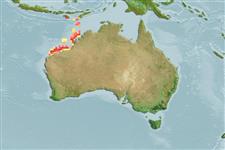Teleostei (teleosts) >
Acanthuriformes (Surgeonfishes) >
Acanthuridae (Surgeonfishes, tangs, unicornfishes) > Nasinae
Etymology: Naso: Latin, nasus = nose (Ref. 45335); mcdadei: Named in honor of Michael McDade, collector of the type specimens (Ref. 37792).
Eponymy: Michael McDade is a spearfisherman and records officer for the Australian Underwater Federation. He has collected and donated specimens to the Queensland Museum, including much of the type material of this species. (Ref. 128868), visit book page.
Environment: milieu / climate zone / depth range / distribution range
Ecology
Marine; reef-associated; depth range 5 - 65 m (Ref. 57178). Tropical; 10°S - 22°S, 114°E - 124°E (Ref. 57253)
Indo-West Pacific: East Africa to the Great Barrier Reef, including the Timor Sea.
Size / Weight / Age
Maturity: Lm ? range ? - ? cm
Max length : 75.0 cm SL male/unsexed; (Ref. 37792)
Short description
Identification keys | Morphology | Morphometrics
Inhabits steep drop-offs of offshore coral reefs or rocky outcrops (Ref. 37792). Feeds on algae and larger zooplankton (Ref. 37792). Solitary or in groups (Ref. 90102). Minimum depth from Ref. 58018.
Life cycle and mating behavior
Maturity | Reproduction | Spawning | Eggs | Fecundity | Larvae
Randall, J.E., 2001. Surgeonfishes of Hawai'i and the world.. Mutual Publishing and Bishop Museum Press, Hawai'i. 123 p. (Ref. 37792)
IUCN Red List Status (Ref. 130435: Version 2024-1)
Threat to humans
Harmless
Human uses
Tools
Special reports
Download XML
Internet sources
Estimates based on models
Preferred temperature (Ref.
123201): 26.4 - 28.2, mean 27.2 °C (based on 40 cells).
Phylogenetic diversity index (Ref.
82804): PD
50 = 0.5000 [Uniqueness, from 0.5 = low to 2.0 = high].
Bayesian length-weight: a=0.02089 (0.00974 - 0.04480), b=2.96 (2.78 - 3.14), in cm total length, based on LWR estimates for this Genus-body shape (Ref.
93245).
Trophic level (Ref.
69278): 2.7 ±0.31 se; based on food items.
Resilience (Ref.
120179): Low, minimum population doubling time 4.5 - 14 years (Preliminary K or Fecundity.).
Fishing Vulnerability (Ref.
59153): High vulnerability (57 of 100).
